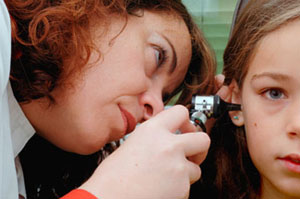Families of Arizona children who were forced to switch from the Children’s Health Insurance Program (CHIP) to private plans sold in the federal marketplace are likely paying more and getting fewer benefits, according to a study released Thursday.
 Millions of families who are ineligible for Medicaid could soon face the same choice if Congress chooses not to extend funding for the state-federal CHIP program when it expires in October 2015. Arizona was the first and only state to end its children’s insurance program — because its state legislature acted before the 2010 Affordable Care Act banned states from reducing children’s health coverage.
Millions of families who are ineligible for Medicaid could soon face the same choice if Congress chooses not to extend funding for the state-federal CHIP program when it expires in October 2015. Arizona was the first and only state to end its children’s insurance program — because its state legislature acted before the 2010 Affordable Care Act banned states from reducing children’s health coverage.
“Arizona provides us a sneak peak of what would happen if CHIP goes away,” said Joan Alker, executive director of the Georgetown University Center on Children and Families which produced the report.
Nationally, CHIP covers about 8 million lower income children, whose families’ income exceeds Medicaid’s eligibility guidelines. If the program ends, many CHIP enrollees would likely have to seek coverage in the new health insurance marketplaces created by the health law.
But many advocates fear that private health plans sold in the exchanges would offer fewer benefits at higher costs and not all families would qualify for Medicaid, even in states that expanded eligibility.
Arizona froze enrollment in CHIP in 2009 and officially closed the program in February — with 26,000 kids shifted to the expanded Medicaid program and the families of the rest offered the option of buying coverage on the federal exchange.
The report found that most Arizona families who shifted from CHIP to private plans would face higher out-of-pocket costs for their children.
Families with the lowest incomes who don’t qualify for Medicaid and those with more than one child would be among the hardest hit, it said. Most children would also face higher costs for dental coverage, the study found.
Arizona’s CHIP program paid the full cost of covered services, meaning there were no deductibles, copays or co-insurance. But such cost-sharing is common in private health plans.
Arizona officials say they don’t know how many of the families of the 14,000 Arizona children who lost CHIP coverage this year and did not qualify for Medicaid bought a private plan in the exchange. But they point out the state led the country in the percent of children whose families bought coverage. About 21 percent of the 120,000 Arizona residents who enrolled in coverage were under age 18. Nationally, just 6 percent of the more than 8 million people who enrolled in that time were children.
Arizona Medicaid spokeswoman Monica Higuera Coury said the private health plans sold in the federal exchange offer comprehensive coverage for children because it was modeled on the state’s employee health plan. “Both CHIP and the marketplace offer comprehensive coverage and Arizona’s numbers show the marketplace is accessible to families with young children,” Coury said. “The CHIP program may be slightly less expensive for some, but not all, families.”
She noted that adding thousands of children to the enrollment pool of private health plans in the state could help keep rates down for everyone because they are overwhelmingly healthy. “Actuaries have explained that the size of the swimming pool matters to the success of the marketplace,” Coury said.
But Alker noted that not all families will be eligible for subsidized private plans because of the so-called “family glitch” in the law. The law requires employers to provide “affordable” insurance only for the workers themselves — not for their families. Premiums for individual coverage must not exceed 9.5 percent of a worker’s income. The “glitch” is that the law does not account for the higher cost of family coverage. There is no limit on the employee’s share of premiums for family coverage, which typically costs close to three times as much as individual coverage.
Although CHIP has had strong bipartisan support, some say the program may face a tough time getting funded next year. “I think CHIP would be on the budget chopping block as a pay-for for something,” said Joe Antos, a health economist at the conservative American Enterprise Institute.
Arizona CHIP had covered children up to twice the federal poverty level, or nearly $48,000 for a family of four, but coverage and benefits vary by state. Medicaid covers everyone in Arizona with incomes below 138 percent of federal poverty — about $33,000 for a family of four.
Like Medicaid, CHIP is administered by the states, but is funded by the federal government and states — with the largest share paid by the federal government. Total spending in fiscal 2013 was $13.2 billion.






